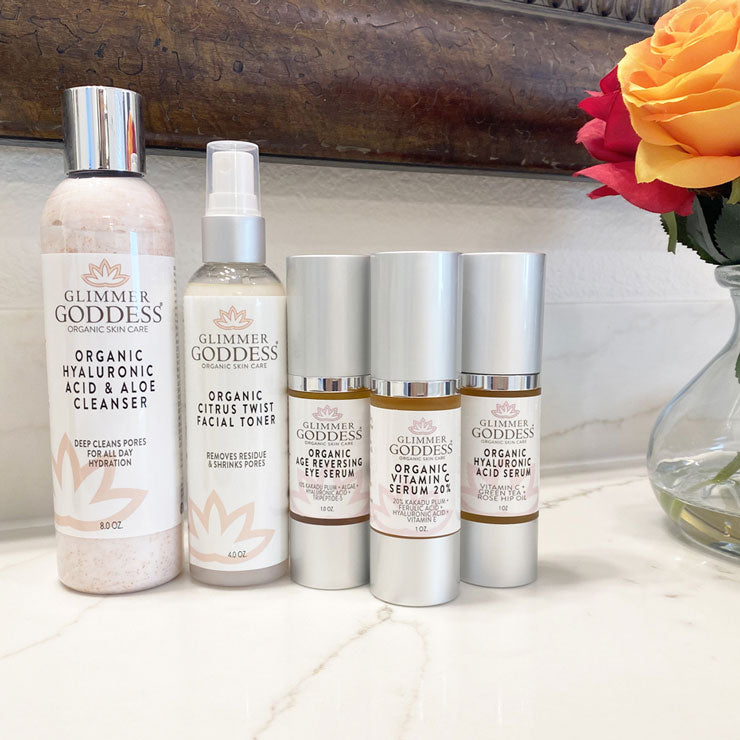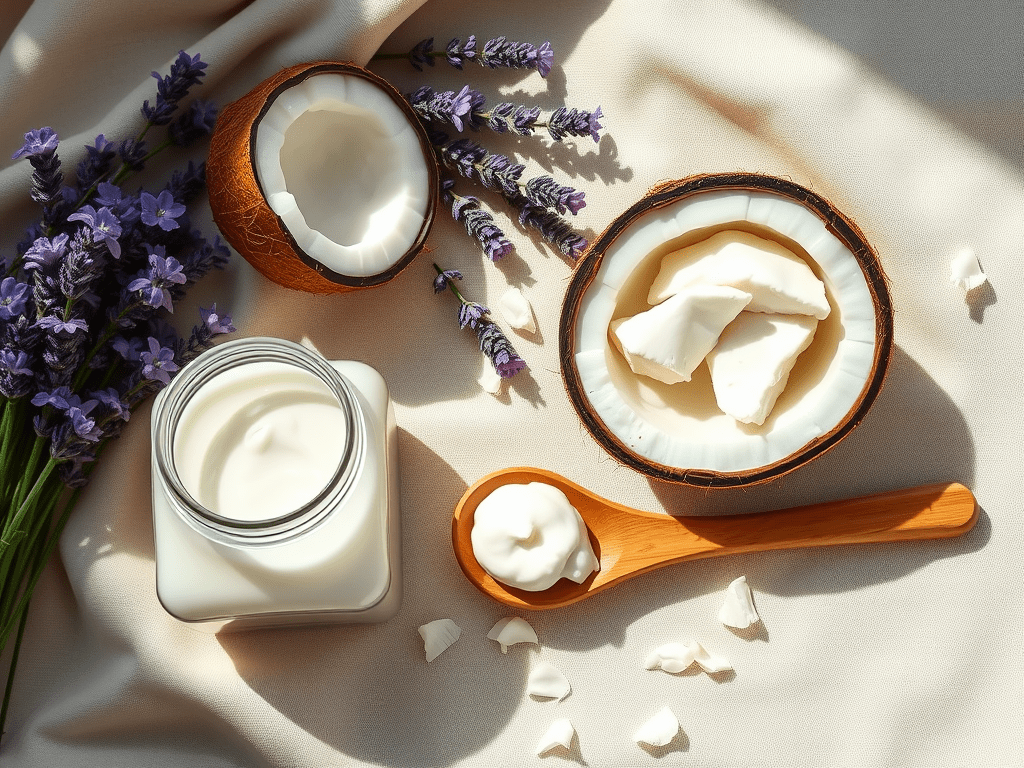
Unlock Your Skin's Radiant Potential: Dive into Organic Beauty 🌺
Protecting our skin from harmful UV rays is more important than ever, and choosing the right sunscreen can make all the difference. In this ultimate guide, we'll delve into the benefits of organic SPF face creams, how they work, their environmental impact, and how to select the perfect product for your skin type. Make the switch today for a healthier, more radiant complexion!
The Skinny on Sunscreen: Why Organic is the Way to Go
Why choose organic over chemical-based sunscreens?
As the sun's rays beat down, protecting our skin becomes a crucial part of our daily routine. But have you ever stopped to consider the ingredients in your sunscreen? Many conventional sunscreens are laden with harsh chemicals that can do more harm than good. Organic sunscreens, on the other hand, offer a natural and gentler alternative that's better for both you and the environment.
When it comes to sunscreen, what you put on your skin matters. Conventional, chemical-based sunscreens often contain concerning ingredients like oxybenzone, avobenzone, and octinoxate. These synthetic compounds can be absorbed into the bloodstream and have been linked to hormone disruption, coral reef damage, and even cancer.
- Oxybenzone, a common sunscreen chemical, has been shown to have estrogenic effects and may interfere with normal hormone function.
- Avobenzone and octinoxate have been found to be toxic to marine life and contribute to the bleaching and death of coral reefs.
- Many of these chemical sunscreens have also been shown to cause skin irritation, allergic reactions, and even free radical damage.
Organic sunscreens offer a much safer and more natural alternative, protecting your skin without exposing you to harmful chemicals.
How do organic ingredients benefit your skin?
When it comes to sunscreen, what you put on your skin matters. Organic sunscreens, made with natural mineral-based ingredients like zinc oxide and titanium dioxide, provide a physical barrier against the sun's rays rather than relying on chemical absorption. This means they are less likely to cause skin irritation or disrupt your body's natural functions.
Organic sunscreens are formulated with plant-based, antioxidant-rich ingredients that nourish and protect your skin. Instead of synthetic chemicals, they utilize natural compounds like vitamin E, aloe vera, and green tea to soothe, hydrate, and shield your skin from harmful UV exposure.
- Vitamin E is a powerful antioxidant that helps neutralize free radicals and prevent premature aging.
- Aloe vera has anti-inflammatory properties that can calm and soothe sunburned skin.
- Green tea is rich in polyphenols that can help repair sun damage and boost skin's natural defenses.
By choosing an organic sunscreen, you're not only protecting your skin from the sun's harmful rays, but also nourishing it with natural, beneficial ingredients.
What are the environmental impacts of traditional SPF?
While conventional sunscreens may offer effective sun protection, their environmental impact is a growing concern. The chemicals used in many mainstream sunscreen formulas have been found to have devastating effects on marine ecosystems, particularly coral reefs.
Studies have shown that chemical sunscreen ingredients like oxybenzone and octinoxate can contribute to the bleaching and death of coral reefs. These compounds can disrupt the coral's natural reproduction and growth processes, leading to the decimation of these vital underwater ecosystems.
- Oxybenzone has been found to cause coral to become more susceptible to bleaching, a process where the coral expels the algae that provide it with nutrients.
- Octinoxate has been shown to inhibit coral's ability to reproduce, leading to a decline in coral populations.
- The accumulation of these chemicals in marine environments can have far-reaching consequences for the entire ocean ecosystem.
Switching to an organic, reef-safe sunscreen is an easy way to help protect the health of our oceans and the incredible diversity of life they support.
Can organic SPF provide the same protection as synthetic options?
When it comes to sun protection, many people are hesitant to switch to organic sunscreens, worried that they won't provide the same level of UV shielding as their synthetic counterparts. However, the latest research suggests that organic, mineral-based sunscreens can be just as effective, if not more so, in safeguarding your skin.
Organic sunscreens containing zinc oxide and titanium dioxide work by physically blocking and reflecting the sun's rays, rather than relying on chemical absorption. This means they can provide broad-spectrum protection against both UVA and UVB radiation, often with a higher SPF rating than many chemical sunscreens.
- Zinc oxide is an incredibly effective natural sun blocker, able to shield against a wide range of UV wavelengths.
- Titanium dioxide also offers excellent broad-spectrum protection and is less likely to cause skin irritation than some chemical filters.
- Organic sunscreens can achieve SPF ratings of 30 or higher, providing the same level of sun protection as their synthetic counterparts.
With the added benefits of natural, skin-nourishing ingredients, organic sunscreens can be a superior choice for keeping your skin safe from the sun's harmful rays.
When should you start using SPF daily?
Protecting your skin from the sun's damaging UV rays should be a year-round priority, not just during the summer months. Dermatologists recommend incorporating a daily SPF into your skincare routine as early as possible, starting in your teens or early 20s.
Daily sun protection is crucial for preventing premature aging, sunspots, and even skin cancer. The sun's rays can penetrate through clouds and windows, so applying sunscreen is important even on overcast or cloudy days.
- The sun's UVA rays can cause long-term damage like wrinkles, fine lines, and age spots, while UVB rays are responsible for sunburns.
- Starting a daily SPF habit early in life can help maintain the health and youthful appearance of your skin as you age.
- Applying sunscreen should be the last step in your morning skincare routine, regardless of your plans for the day.
By making sunscreen a daily essential, you're investing in the long-term health and beauty of your skin. It's a simple habit that can have a big impact on your complexion for years to come.
In conclusion, the switch to organic sunscreen is a smart and necessary choice for both your personal health and the health of our planet. By opting for natural, mineral-based formulas, you can enjoy the same reliable sun protection without exposing yourself or the environment to harmful chemicals. So why not make the switch and let your skin bask in the glow of nature's goodness?
The Ultimate Guide to Choosing the Perfect Sunscreen
What ingredients should you look for in your SPF?
When it comes to finding the right sunscreen, the ingredients list is key. Not all sunscreens are created equal, and the active ingredients can make a big difference in terms of effectiveness and skin-friendliness.
Navigating the Sunscreen Ingredient Maze
- Look for sunscreens that contain either mineral (zinc oxide or titanium dioxide) or a combination of mineral and chemical (avobenzone, oxybenzone, etc.) active ingredients.
- Mineral sunscreens tend to be less irritating and work by physically blocking and reflecting UV rays, while chemical sunscreens absorb the rays.
- Avoid sunscreens with harsh chemicals like oxybenzone, which can be harsh on sensitive skin and are linked to environmental concerns.
- Opt for sunscreens with moisturizing ingredients like vitamin E, aloe vera, or hyaluronic acid to nourish your skin while protecting it.
How can you identify your skin type effectively?
Knowing your skin type is crucial when choosing the right sunscreen, as different formulas work better for different skin conditions. Luckily, there are a few simple ways to determine your skin type._
Determining Your Skin Type
- Perform a blotting test: Gently blot your face with a tissue or paper towel. If the paper picks up a lot of oil, you likely have oily skin. If it's mostly dry, you have dry skin. If it's a mix, you have combination skin.
- Observe your skin's reaction to products: If your skin frequently feels tight, flaky, or irritated, you likely have dry skin. If it's shiny and prone to breakouts, you have oily skin. If certain areas are dry while others are oily, you have combination skin.
- Consider your pore size: Larger pores are usually a sign of oily skin, while smaller pores indicate drier skin.
What are the best organic SPF options for oily, dry, and combination skin?
When it comes to organic sunscreen options, there are plenty of great choices to suit different skin types. Here are some of the best picks for oily, dry, and combination skin.
Oily Skin
- Look for oil-free, non-comedogenic (won't clog pores) sunscreens with a matte or satin finish.
- Try mineral sunscreens with zinc oxide or titanium dioxide, as they provide a lightweight, non-greasy feel.
- Consider sunscreens with mattifying ingredients like silica or oil-absorbing powders.
Dry Skin
- Opt for sunscreens with hydrating, nourishing ingredients like glycerin, ceramides, or antioxidants.
- Choose creamy, emollient formulas that won't leave your skin feeling tight or uncomfortable.
- Look for sunscreens that contain natural oils like jojoba, argan, or coconut oil to lock in moisture.
Combination Skin
- Find a versatile sunscreen that can address both oily and dry areas.
- Go for a formula that's not too heavy or greasy, but still provides enough hydration.
- Consider a dual-action sunscreen with both mineral and chemical filters for comprehensive protection.
How does the SPF rating affect your choice?
The SPF (Sun Protection Factor) rating is a crucial consideration when selecting a sunscreen. This number indicates how much of the sun's UVB rays the product can block.
Understanding SPF Levels
- An SPF 30 sunscreen blocks approximately 97% of UVB rays, while SPF 50 blocks about 98%.
- Higher SPF numbers don't necessarily mean significantly better protection. The difference between SPF 30 and SPF 50 is only about 1%.
- For daily use, an SPF of 30 or higher is generally recommended. For extended outdoor activities, aim for an SPF of 50 or higher.
- Be sure to apply enough sunscreen (about 1 ounce per application) to achieve the full SPF coverage.
What's the importance of broad-spectrum protection?
In addition to the SPF rating, it's crucial to look for sunscreens that provide broad-spectrum protection. This means the product shields against both UVA and UVB rays.
The Dangers of UVA and UVB Rays
- UVB rays are the primary culprit behind sunburns and can also contribute to skin cancer.
- UVA rays penetrate deeper into the skin, causing long-term damage like premature aging, wrinkles, and increased risk of skin cancer.
- Broad-spectrum sunscreens with both mineral and chemical filters offer the most comprehensive protection against the full spectrum of harmful UV rays.
- Look for the "broad-spectrum" label on the product and check the active ingredients to ensure you're getting the best possible defense against sun damage.
Choosing the right sunscreen can be a daunting task, but by understanding the key factors like active ingredients, skin type, SPF rating, and broad-spectrum protection, you can find the perfect formula to keep your skin safe and healthy all year round. Remember, sun protection is essential, so don't skimp on the SPF - your skin will thank you in the long run.
The Ultimate Guide to Sun Protection: Unlocking the Power of SPF
What are the best practices for applying SPF?
When it comes to sun protection, applying SPF (Sun Protection Factor) is one of the most crucial steps in any skincare routine. However, many people don't fully understand the correct way to apply it for maximum effectiveness. Here are some best practices to ensure your SPF does its job.
The Importance of Proper Application
- The amount of SPF you apply directly impacts the level of protection it provides. Underestimating the amount can significantly reduce the SPF's efficacy.
- Most people only apply 25-50% of the recommended amount, which can cut the SPF's protection in half or more.
- The recommended amount is about 1/4 teaspoon for the face and 1 ounce (about a shot glass full) for the entire body.
- Applying SPF evenly and thoroughly is key to ensure even coverage and protection.
When to Apply SPF
- SPF should be applied as the last step in your morning skincare routine, after all other products have been absorbed.
- It's important to apply SPF 15-30 minutes before sun exposure to allow the ingredients to bind to the skin.
- Reapplication is crucial, as SPF effectiveness decreases over time and with activities like swimming or sweating.
Choosing the Right SPF Level
- The SPF number indicates the level of protection from UVB rays. For example, SPF 30 blocks 97% of UVB rays.
- For daily use, the recommended minimum is SPF 30. For extended outdoor activities, SPF 50+ is ideal.
- Look for broad-spectrum SPF that also protects against UVA rays, which can cause premature aging.
Applying SPF properly is essential for effective sun protection. By following these best practices, you can ensure your skin is shielded from the harmful effects of UV radiation.
How can SPF be integrated into your skincare regimen?
Incorporating SPF into your daily skincare routine is crucial for maintaining healthy, youthful-looking skin. Here's how you can seamlessly integrate sun protection into your regimen.
Choosing the Right SPF Product
- Look for SPF-infused moisturizers, serums, or primers that provide both hydration and sun protection.
- Select a formula that suits your skin type, whether it's oily, dry, or sensitive.
- Consider the finish you prefer, such as matte, dewy, or satin.
Layering SPF with Other Products
- Apply SPF as the last step in your morning skincare routine, after serums, moisturizers, and other treatments.
- If using a separate SPF product, make sure to allow it to fully absorb before applying makeup.
- Be mindful of the order of application to ensure the SPF isn't diluted or compromised by other products.
Choosing the Right SPF for Your Lifestyle
- If you have an active lifestyle or spend a lot of time outdoors, opt for a water-resistant or sweat-proof SPF.
- For everyday wear, a tinted SPF or one with skincare benefits can provide a subtle, natural-looking finish.
- Consider your climate and adjust your SPF accordingly, as different environments may require higher or lower protection.
Incorporating SPF into Your Makeup Routine
- Look for makeup products that contain SPF, such as foundations, BB/CC creams, or powders.
- Apply these products after your SPF moisturizer for an extra layer of protection.
- Remember that makeup-infused SPF should not replace a dedicated SPF product, as the coverage may not be sufficient.
Integrating SPF into your daily skincare and makeup routine is an essential step in maintaining healthy, protected skin. By choosing the right products and incorporating them seamlessly, you can enjoy the benefits of comprehensive sun protection.
What are common mistakes when using SPF?
While sun protection is crucial, many people make common mistakes when it comes to using SPF effectively. Avoiding these pitfalls can help ensure your skin stays safe and healthy.
Inadequate Application
- Applying too little SPF is one of the most common mistakes, as it significantly reduces the product's efficacy.
- Failing to cover all exposed areas, such as the lips, ears, and around the eyes, can leave vulnerable spots unprotected.
- Not reapplying SPF throughout the day, especially after swimming, sweating, or toweling off, can leave skin exposed to harmful UV rays.
Relying on a Single SPF Product
- Depending solely on a single SPF product, such as a moisturizer or foundation, may not provide sufficient protection.
- The SPF in these products is often lower than the recommended minimum of SPF 30.
- Layering a dedicated SPF product over your other skincare and makeup can ensure comprehensive sun protection.
Ignoring Expiration Dates
- SPF products can lose their effectiveness over time, especially when exposed to high temperatures or direct sunlight.
- Using an expired SPF product can leave your skin vulnerable to sun damage.
- Always check the expiration date and discard any products that have passed their shelf life.
Neglecting Certain Sun Exposure Situations
- Many people forget to apply SPF on cloudy or overcast days, believing the sun's rays are not as strong.
- UV radiation can still penetrate through clouds and cause skin damage, so consistent SPF application is crucial.
- Activities like driving, spending time near windows, and using tanning beds also require sun protection.
Failing to Protect Sensitive Areas
- Forgetting to apply SPF to commonly overlooked areas, such as the lips, ears, and around the eyes, can lead to painful sunburns and long-term damage.
- These delicate areas require special attention and the use of SPF-infused products designed for sensitive skin.
Avoiding these common SPF mistakes can help ensure your skin is properly protected and minimize the risk of sun-related damage. By being mindful of proper application, product selection, and consistent use, you can enjoy the benefits of comprehensive sun protection.
How often should you reapply SPF throughout the day?
Reapplying SPF throughout the day is crucial for maintaining adequate sun protection, but the frequency can vary depending on your activities and environment. Here's a guide on when and how often to reapply SPF.
Frequency of Reapplication
- As a general rule, SPF should be reapplied every 2 hours when spending extended time outdoors.
- If you're engaging in activities that involve water, sweating, or direct sun exposure, reapplication should be done more frequently, such as every 60-90 minutes.
- For everyday wear, reapplying SPF every 4-6 hours is recommended, even on days when you're not spending significant time outside.
Factors to Consider
- The type of SPF product you're using, as some formulas may be more water-resistant or long-lasting than others.
- Your skin type and sensitivity, as oily or sweaty skin may require more frequent reapplication.
- The intensity of the sun's rays, which can vary based on location, time of day, and weather conditions.
- Whether you're engaging in activities that can remove or compromise the SPF, such as swimming, exercise, or rubbing your skin.
Reapplication Techniques
- Carry a compact or travel-sized SPF product for easy reapplication throughout the day.
- Apply SPF to all exposed areas, including the face, neck, ears, and hands.
- For makeup-wearers, use a powder or setting spray-based SPF product to avoid disrupting your makeup.
- When reapplying over makeup, gently pat or press the SPF into the skin rather than rubbing it in.
Importance of Consistency
- Consistent, thorough reapplication is crucial for maintaining the full protective benefits of SPF.
- Skipping or inconsistent reapplication can leave your skin vulnerable to sun damage and premature aging.
- Make reapplication a habit, and incorporate it into your daily routine for optimal sun protection.
Regularly reapplying SPF is essential for comprehensive sun protection. By understanding the frequency and techniques for reapplication, you can ensure your skin stays shielded from harmful UV rays throughout the day.
Can you combine SPF with makeup?
Combining SPF with makeup can be an effective way to achieve comprehensive sun protection while maintaining a flawless, radiant complexion. However, there are a few important considerations to keep in mind when integrating SPF into your makeup routine.
Choosing SPF-Infused Makeup Products
- Look for foundations, BB/CC creams, powders, and other makeup products that contain built-in SPF.
- These formulas are designed to provide both sun protection and coverage, making them a convenient option.
- When selecting SPF-infused makeup, choose a minimum of SPF 30 for optimal protection.
Applying SPF Before Makeup
- It's essential to apply a dedicated SPF product as the last step in your skincare routine, before applying makeup.
- This ensures the SPF is properly absorbed and provides a solid foundation for your makeup application.
- Allowing the SPF to fully set and dry before applying makeup will prevent any pilling or disruption of the makeup.
Reapplying SPF Over Makeup
- Throughout the day, you'll need to reapply SPF to maintain adequate protection, even if you're wearing makeup.
- Look for powder-based or setting spray SPF products that can be easily applied over makeup without disturbing the finish.
- Gently press or pat the SPF product onto the skin, rather than rubbing it in, to avoid disrupting your makeup.
Considering Makeup Removal
- When removing your makeup at the end of the day, be sure to cleanse thoroughly to remove any remaining SPF.
- This will allow your skin to "breathe" and prevent any potential clogging or irritation from the SPF ingredients.
- Follow up with your evening skincare routine, including any treatments or moisturizers your skin may need.
Balancing SPF and Makeup Needs
- Experiment with different SPF-infused makeup products to find the right balance between sun protection and your desired coverage and finish.
- If you find that SPF-infused makeup alone doesn't provide sufficient protection, consider layering a dedicated SPF product underneath.
- Prioritize sun protection while still achieving your desired makeup look and feel.
Combining SPF with makeup can be an effective way to shield your skin from harmful UV rays while maintaining a flawless complexion. By following best practices and choosing the right products, you can seamlessly integrate sun protection into your daily makeup routine.
Unlock Your Skin's Radiant Potential: Dive into Organic Beauty 🌺
Organic Vitamin C Face Cream Reef-Safe SPF 30 - Brightens and Tightens Skin
Elevate your skincare routine with our Organic Vitamin C Face Cream SPF 30. Crafted with nature's finest ingredients, this multifunctional cream restores a healthy, luminous complexion while shielding your skin from harmful UV rays.
Discover the power of this transformative facial moisturizer:
- 🍊 Vitamin C: A powerhouse antioxidant that brightens, evens tone, and stimulates collagen production for a youthful, firm appearance.
- 🌊 Sea Buckthorn Oil: Rich in essential fatty acids and vitamins, this ingredient helps reduce inflammation, improve skin elasticity, and enhance radiance.
- 🍎 Pomegranate Oil: Packed with polyphenols, this oil works to tighten and firm the skin, minimizing the appearance of fine lines and wrinkles.
- 🌅 Broad-Spectrum SPF 30: Provides protection against both UVA and UVB rays, guarding your skin from sun damage and premature aging.
- 🌱 Reef-Safe Formula: Our sunscreen is formulated with mineral-based, non-nano zinc oxide, ensuring it's safe for both you and the ocean.
Triple Action Daily Organic Face Moisturizer
Unlock your skin's true potential with our Triple Action Daily Organic Face Cream SPF 30. This nourishing, multitasking formula combines powerful natural ingredients to combat wrinkles, shield against sun damage, and promote a radiant, youthful glow.
Dive into the transformative benefits of this face cream:
- 🥕 Carrot Seed Oil: Rich in antioxidants and vitamins, this oil helps stimulate collagen production, reduce the appearance of fine lines and wrinkles, and improve skin elasticity.
- 🍇 Pomegranate Oil: Packed with polyphenols, this ingredient works to tighten and firm the skin, minimizing the visible signs of aging.
- 🍓 Raspberry Seed Oil: A lightweight, non-greasy oil that intensely hydrates and nourishes the skin, leaving it smooth and supple.
- 🌅 Broad-Spectrum SPF 30: Protects your skin from harmful UVA and UVB rays, preventing sun damage and premature aging.
- 🌱 Reef-Safe Formula: Our sunscreen is formulated with mineral-based, non-nano zinc oxide, making it safe for both you and the ocean.
Q&A
What are the advantages of using organic SPF face creams?
Organic SPF face creams are safer for your skin and the environment, as they use natural ingredients that provide effective sun protection without the harmful chemicals commonly found in conventional sunscreens.
How do I choose the right organic sunscreen for my skin type?
Determine your skin type (oily, dry, or combination) and look for organic SPF products specifically formulated to address your needs. For oily skin, choose oil-free formulas; for dry skin, opt for moisturizing options.
Can organic sunscreens offer the same level of protection as chemical-based options?
Yes, organic sunscreens containing mineral ingredients like zinc oxide and titanium dioxide can provide equivalent, if not better, protection from both UVA and UVB rays.
What is the environmental impact of conventional sunscreens?
Conventional sunscreens often contain harmful chemicals that can damage marine ecosystems, particularly coral reefs. Switching to organic sunscreens helps protect our oceans.
How often should I apply organic sunscreen?
Apply organic sunscreen every two hours when outdoors, or more frequently if swimming or sweating. For daily wear, reapply every 4-6 hours to maintain adequate protection.
Making the switch to organic SPF face creams is not only a wise choice for your skin but also for the environment. By selecting natural, mineral-based formulas, you can enjoy effective sun protection while nourishing your skin with beneficial ingredients. Start your journey to healthier skin today and embrace the goodness of organic sunscreen!








